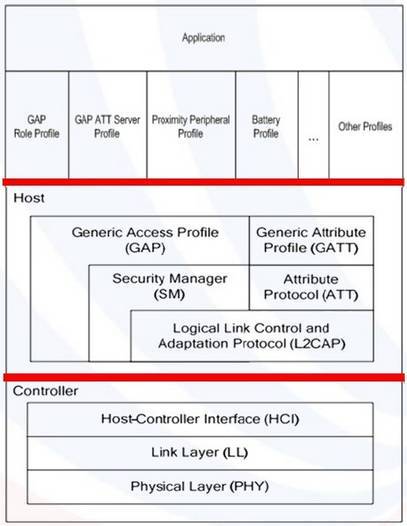
Bluetooth Low Energy (BLE) has become a cornerstone technology for wireless communication, particularly in the realm of the Internet of Things (IoT). Its architecture is designed to support a wide range of applications while maintaining low power consumption. This article provides an overview of the BLE structure, examining the components and layers that make up this versatile technology.
The BLE Protocol Stack
The BLE protocol stack is based on the OSI model and consists of several layers, each with specific responsibilities:
- Physical Layer (PHY): This layer deals with the actual transmission and reception of raw binary data over the air. It defines the radio frequency used by BLE, which is in the 2.4 GHz band.
- Link Layer (LL): The link layer manages the establishment, maintenance, and termination of connections between devices. It handles functions such as data framing, error detection, and flow control.
- Logical Link Control and Adaptation Protocol (L2CAP): L2CAP extends the services of the lower layers by providing additional protocol mechanisms to support the higher layers. It manages the segmentation and reassembly of data packets and provides a multiplexing service for upper-layer protocols.
- Host Controller Interface (HCI): The HCI layer provides an interface between the host and the controller. It facilitates the exchange of commands, events, and data between the application layer on the host and the lower layers in the controller.
- Security Manager Protocol (SMP): SMP is responsible for device authentication and key exchange, ensuring secure communication between BLE devices.
- Attribute Protocol (ATT): The ATT layer is used for exchanging data between devices. It provides a standardized way to read and write attributes, such as device characteristics and settings.
- Generic Attribute Profile (GATT): GATT is a higher-level protocol that defines a model for organizing attributes into a structured format. It allows for the discovery and interaction with services and characteristics provided by a BLE device.
Key Components of BLE Devices
BLE devices consist of several key components:
- Controller: Manages the radio frequency communication and implements the lower layers of the BLE protocol stack.
- Host: Contains the application logic and implements the higher layers of the BLE protocol stack.
- Application: The specific software running on the host that utilizes BLE for communication and data exchange.
- Firmware: The software that controls the operation of the BLE controller.
Advantages of the BLE Structure
The structure of BLE offers several advantages:
- Low Power Consumption: The design of the protocol stack and the operation of the controller contribute to the low power usage of BLE devices.
- Scalability: The分层 structure allows for easy expansion and adaptation to different application requirements.
- Interoperability: The standardized protocol stack ensures compatibility between devices from different manufacturers.
- Flexibility: The modular nature of the BLE architecture allows for various configurations to suit different use cases.
Challenges in BLE Structure
Despite its advantages, the BLE structure also presents challenges:
- Complexity in Implementation: The multiple layers and protocols can make the implementation of BLE devices complex.
- Security Concerns: Ensuring secure communication and protecting against vulnerabilities is a continuous challenge.
- Interference: BLE devices can be susceptible to interference from other wireless signals in the 2.4 GHz band.
Conclusion
The structure of BLE is a testament to its versatility and efficiency, making it a popular choice for a wide range of wireless applications. By understanding the layers of the BLE protocol stack and the components of BLE devices, developers can effectively harness this technology to create innovative solutions. As BLE continues to evolve, its architecture will likely be refined to address emerging challenges and to support new applications, further cementing its place in the connected world.



